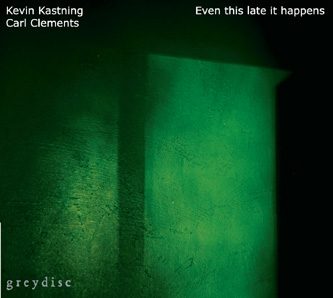 Guitar
explorer Kevin Kastning has made several fine albums with sax
/ flute virtuoso Carl Clements and, recording once again as
a duo they continue onward with their eight track, 77 minute, 2017
CD Even this late it happens. With Kastning delving
into his arsenal of multi-string guitars, including the 36-string
Double Contraguitar, the 30-string Contra-Alto guitar and the 15-string
Extended Classical guitar, he merges his freeform musical trains of
thought with Carl Clements, who excels on tenor and soprano saxophones
and flutes. Listeners who were lucky enough to hear the duo’s
2016 album A Far Reflection won’t be disappointed with
Even this late it happens. Speaking about the boundless musical
dynamics on their new album, Carl Clements tells mwe3.com "I
think there are infinite possibilities in the music we’re doing,
so there will always be new ideas and approaches to draw from",
with Kastning adding, "When Carl and I start recording
sessions for a new album, we discuss the direction for that album
and then move into that direction and that space. Our rapport or connection
has always been there, but over all these years, it just seems to
only get stronger." The mood of Even this late it happens
is somber yet illuminating, with the duo's dreamlike musical patterns
winding down dark and mysterious pathways. With their integrated mixture
of neoclassical, avant-garde and improvisational sounds, Kastning
and Clements are quite rightly considered two of America’s leading
21st century sonic pioneers. www.kevinkastning.com
/ www.carlclements.com
Guitar
explorer Kevin Kastning has made several fine albums with sax
/ flute virtuoso Carl Clements and, recording once again as
a duo they continue onward with their eight track, 77 minute, 2017
CD Even this late it happens. With Kastning delving
into his arsenal of multi-string guitars, including the 36-string
Double Contraguitar, the 30-string Contra-Alto guitar and the 15-string
Extended Classical guitar, he merges his freeform musical trains of
thought with Carl Clements, who excels on tenor and soprano saxophones
and flutes. Listeners who were lucky enough to hear the duo’s
2016 album A Far Reflection won’t be disappointed with
Even this late it happens. Speaking about the boundless musical
dynamics on their new album, Carl Clements tells mwe3.com "I
think there are infinite possibilities in the music we’re doing,
so there will always be new ideas and approaches to draw from",
with Kastning adding, "When Carl and I start recording
sessions for a new album, we discuss the direction for that album
and then move into that direction and that space. Our rapport or connection
has always been there, but over all these years, it just seems to
only get stronger." The mood of Even this late it happens
is somber yet illuminating, with the duo's dreamlike musical patterns
winding down dark and mysterious pathways. With their integrated mixture
of neoclassical, avant-garde and improvisational sounds, Kastning
and Clements are quite rightly considered two of America’s leading
21st century sonic pioneers. www.kevinkastning.com
/ www.carlclements.com
mwe3.com presents a new interview with
Kevin Kastning and Carl Clements
mwe3: How did you come up with the title Even this late it
happens and did the sessions inspire the album title or does the
title make some other statement? Does it possibly reflect upon discovering
some new musical ideas that dawned on you both during the album and
were any new musical ideas brought to light on Even this late it
happens during the discussions as to what directions to take on
the new album?
Kevin Kastning: I put the album title together one night when
I was reading some poetry by Mark Strand. Something I read triggered
that as a title, so I ran it by Carl to get his opinion. I thought
it fit this project, and Carl did as well. By the time I figured out
the title, the album was already completely recorded. I don't think
I've ever had the title before the album was recorded. I don't know
what the title should be until everything is completed; the title
is always based on the music. I don't want to say too much about how
and why I think the title fits this record, as I'd rather leave it
to each listener to find a connection.
mwe3: In your estimation is Even this late it happens more
whimsical and lighthearted than 2016’s A Far Reflection in
the way the music was constructed? Were there any untapped musical
ideas from the previous Kastning / Clements album that influenced
Even this late it happens and what did you learn from your
earlier albums that might have helped refine the musical ideas and
your sonic rapport on Even this late it happens?
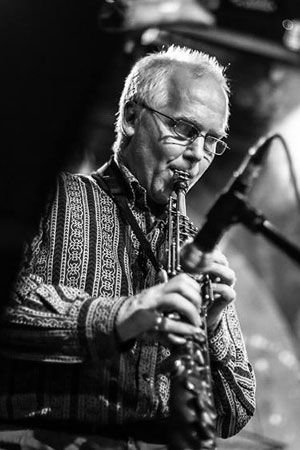 Kevin
Kastning: I don't think there were untapped ideas that remained
from previous projects, no. When Carl and I start recording sessions
for a new album, we discuss the direction for that album and then
move into that direction and that space. Our rapport or connection
has always been there, but over all these years, it just seems to
only get stronger.
Kevin
Kastning: I don't think there were untapped ideas that remained
from previous projects, no. When Carl and I start recording sessions
for a new album, we discuss the direction for that album and then
move into that direction and that space. Our rapport or connection
has always been there, but over all these years, it just seems to
only get stronger.
Carl Clements: I don’t think we set out to be more whimsical
and lighthearted, but due to the improvised nature of our music, each
project very much reflects the mood of the moment. The tracks are
the result of multiple recording dates, so I think the mood may vary
significantly from one piece to the next. I don’t think that
we were considering specifically what was untapped from the previous
project, but I think there are infinite possibilities in the music
we’re doing, so there will always be new ideas and approaches
to draw from. I don’t see it as improvement, but rather a separate
set of musical conversations. That said, I think the more we play
together, the stronger our rapport.
mwe3: Kevin plays the 36-string Double Contraguitar, the 30-string
Contra-Alto guitar and the 15-string Extended Classical guitar on
Even this late it happens but the album credits don’t
list which guitars are featured on what tracks. Can you let us know
which guitars Kevin used on each of the tracks and were there other
devices used this time such as using the ebow on the 36 string?
Kevin Kastning: I didn't use the Ebow on this record. Here
are the instruments track by track for Even this late it happens:
Tracks: Kevin
Kastning / Carl
Clements
1 To the presence of movement 15-string
Extended Classical guitar / Tenor
saxophone
2 No longer known; no longer in sight 36-string
Double Contraguitar / Soprano saxophone
3 A veil of absence 36-string
Double Contraguitar / Soprano saxophone
4 Corridors unconsidered 36-string
Double Contraguitar Alto
flute / Bansuri flute
5 Imaginary chapters 15-string
Extended Classical guitar / Tenor
saxophone
6 Circles and waiting 15-string
Extended Classical guitar / Soprano
saxophone
7 Words laid upon a table 30-string
Contra-Alto guitar / Soprano
saxophone
8 The wings of night 15-string
Extended Classical guitar / Tenor
saxophone
mwe3: Is Carl’s saxophone sound more prevalent on Even
this late it happens compared to say Watercolor Sky and
A Far Reflection? Which instruments did Carl play most on Even
this late it happens and were there any new wind and horn sounds
discovered on Even this late it happens?
Carl Clements: I did end up playing a fair amount of saxophone
on Even this late it happens as I only used flute on one track.
Other albums have feature the flute a bit more, though I do still
think of the saxophones, tenor and soprano mostly, as my primary instruments.
I’m featured most on soprano on Even this late it happens...
mwe3: You said earlier that A Far Reflection was more
contrapuntal, compared to your other albums so was Even this late
it happens contrapuntal or meditative comparatively? I liked Carl’s
word ‘rasa’ which he used to describe the mood of each piece.
What was the rasa like in the studio while making the new album?
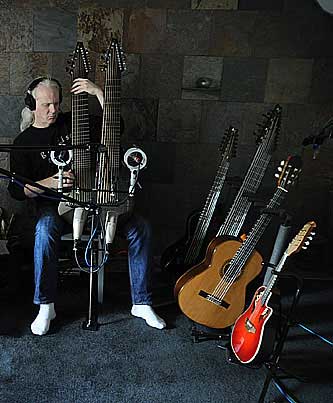 Kevin
Kastning: The album was recorded during three recording sessions.
The first was in December 2016, and the other two were a week apart
in June 2017. In my opinion, Even this late it happens is more
contrapuntal than meditative, but I think it's a record which will
impact each listener in a different way; some may hear it as more
meditative. The studio rasa was contemplative and almost meditative,
in my opinion. Carl may have other thoughts on this!
Kevin
Kastning: The album was recorded during three recording sessions.
The first was in December 2016, and the other two were a week apart
in June 2017. In my opinion, Even this late it happens is more
contrapuntal than meditative, but I think it's a record which will
impact each listener in a different way; some may hear it as more
meditative. The studio rasa was contemplative and almost meditative,
in my opinion. Carl may have other thoughts on this!
Carl Clements: I can’t really label Even this late
it happens as specifically meditative or contrapuntal. In some
ways our album Watercolor Sky was unique in this regard, since
we specifically selected tracks that were more meditative in nature.
A Far Reflection, which followed Watercolor Sky, had
more contrapuntal elements in comparison, but generally I think our
albums explore too many textures to label them in those terms. Even
this late it happens has some tracks that are contrapuntal, some
that are exchanges of musical statements, some that involve one of
us taking a supportive role while the other takes the foreground—and
this will usually alternate within a given track. Regardless of the
texture, though, I feel like almost all of our music serves as a kind
of meditation, in that we immerse ourselves in the moment and allow
the music to happen. This is true of fast, contrapuntal pieces as
much as slow, textural pieces.
mwe3: You mentioned before that your music often defies musical
categories and that it includes all types of genres—from experimental
classical to avant-garde jazz and World Music. When you plan and create
your recordings do you think in terms of genre at all? Kevin had mentioned
some very insightful terms saying that when you plan out an album
you think in terms like structure, register and harmonic and rhythmic
concepts. Can you elaborate on those terms like structure and register
and how do they come into play on Even this late it happens…
for example, on the lead off track “To the presence of movement”
and throughout the album?
Kevin Kastning: Neither Carl nor I think in terms of genre
as it applies to our records. We don't say "Let's make this more
of a jazz record;" we just plan a compositional direction for
the record, and then discuss that and break it down on a composition-by-composition
basis. We only want to follow our own direction, regardless of genre.
Regarding structure, this is in terms of the overall shape of the
composition. For example, in a symphony, the structure may be that
the string section has an exposed part or section, then the woodwinds
have their highlighted part, then maybe both the strings and woodwinds
have a composed section where they are both active. That is a type
of structure.
For register, it's something we always discuss. My instruments have
a much wider and broader range than a 6-string guitar. The total of
Carl's instruments cover a wide range as well, from tenor saxophone
to flute. We discuss instrument ranges and combinations of ranges,
which also includes discussing instrument combinations and colors.
The opening track is 15-string extended classical guitar and tenor
saxophone. Together, these provide an interesting and unique texture.
To my way of thinking and hearing, the classical guitar voice is more
delicate and fragile than the steel-string voice. The tenor sax has
a big, wide voice, which is located in Carl's lower registers. So
to combine this strong woodwind voice with the more exposed and fragility
of the classical guitar makes for a beautiful color and textural combination.
These colors and textures can and do impact and even sometimes determine
the direction of a composition.
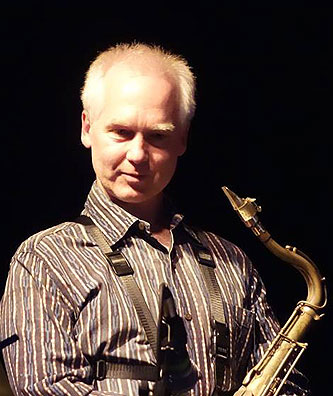 Carl
Clements: Kevin and I are both inspired by a wide range of music,
but it isn’t our intention to fit into any specific category.
Because we rely so strongly on improvisation, there might be a tendency
for some to categorize the music as jazz. And it’s certainly
true that jazz is a big part of my musical life, in that I’ve
long studied and listened to jazz, I teach jazz saxophone and improvisation
at Amherst College and UMass, and I often play in settings that would
typically be categorized as jazz. However, I’m also deeply involved
with Hindustani classical music, which is another largely improvised
music, and there are many improvising traditions around the world
that have no direct relation to jazz. Since improvisation is essentially
spontaneous composition, it can result in any style, or no style at
all—at least no style that’s yet been defined. When Kevin
and I improvise together, we react to each other rather than a predetermined
set of stylistic expectations. This helps to pull us out of any patterns
or tendencies that we might fall into individually.
Carl
Clements: Kevin and I are both inspired by a wide range of music,
but it isn’t our intention to fit into any specific category.
Because we rely so strongly on improvisation, there might be a tendency
for some to categorize the music as jazz. And it’s certainly
true that jazz is a big part of my musical life, in that I’ve
long studied and listened to jazz, I teach jazz saxophone and improvisation
at Amherst College and UMass, and I often play in settings that would
typically be categorized as jazz. However, I’m also deeply involved
with Hindustani classical music, which is another largely improvised
music, and there are many improvising traditions around the world
that have no direct relation to jazz. Since improvisation is essentially
spontaneous composition, it can result in any style, or no style at
all—at least no style that’s yet been defined. When Kevin
and I improvise together, we react to each other rather than a predetermined
set of stylistic expectations. This helps to pull us out of any patterns
or tendencies that we might fall into individually.
Structure, register, harmonic and rhythmic concepts, and various other
musical elements such as melodic and thematic elements, shapes, use
of space, etc., are certainly integral to the music we make together.
Sometimes aspects of these will be briefly discussed beforehand, but
it’s mostly determined in process. In the track you mentioned,
“To the presence of movement,” there is a descending figure
played on tenor sax that is echoed as a strong thematic element for
much of the piece, and contrasted by a more jagged theme. I think
both of these themes, as well as various other elements, help to provide
a kind of structural continuity. But I really think of our interactions
as musical conversations, so the music is free to move in any direction.
Generally, though, I think the initial musical statements in any of
our pieces play a strong role in determining the direction of the
rest of the piece.
mwe3: Regarding Kevin’s 36-string Double Contraguitar,
has there been any news on the instrument since over the past year?
How is it holding up and how do you maintain an instrument of such
complexity? Also have other artists started to use the 36 or is it
still way to complicated for most guitarists to fathom and perform?
Also have you explored other new techniques in playing the twin necks
at the same time and how about some videos on the 36 string?
Kevin Kastning: The 36 is doing great. The carbon fiber instruments
are fantastic in so many ways, but one advantage they have over wood
instruments is stability and reliability. I've been playing them for
5 or 6 years now, and I've not had a single issue. I come to love
carbon fiber instruments more and more, and for what I'm doing with
these big multi-string instruments, carbon fiber is superior to wood.
The only drawback to these instruments is that it takes over three
hours to change strings on the 36!
The techniques for these instruments seems to be continually evolving
and developing. Both in seeing each neck and tuning separately, and
seeing them simultaneously together as a single instrument. Hardly
a week goes by where I don't learn something new with them, or find
a new technique, or stumble across a hidden secret they hold. Some
performance videos are indeed in the works. I'm not sure when they'll
be completed, but hopefully soon. They'll be available on YouTube.
As far as I know, no one else is using these instruments. It could
be the added complexity and learning curve… I can't say.
mwe3: How many instruments has Kevin invented over the past
15 years and which of these inventions is he the most proud of? How
many guitars are in Kevin’s collection of guitars and does he
consider himself as much of an inventor as a guitarist and composer?
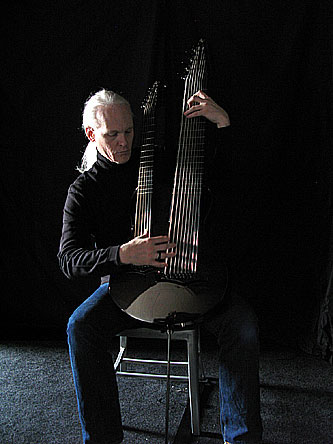 Kevin
Kastning: I get a little squeamish at the word "invented,"
as I never set out to actually invent a new instrument; nor do I consider
myself as an instrument inventor. And I think they may be more of
an evolution of the guitar rather than an entirely new instrument;
I don't know. So maybe "designed" could be a more honest
term than "invented." As for how many instruments I've designed,
I'd guess about 8 or 9 that have been completed. There are three new
ones that are presently in the works.
Kevin
Kastning: I get a little squeamish at the word "invented,"
as I never set out to actually invent a new instrument; nor do I consider
myself as an instrument inventor. And I think they may be more of
an evolution of the guitar rather than an entirely new instrument;
I don't know. So maybe "designed" could be a more honest
term than "invented." As for how many instruments I've designed,
I'd guess about 8 or 9 that have been completed. There are three new
ones that are presently in the works.
I don't think there is a single one of which I'm more proud than the
others. However, my current main instrument is the 36-string. It feels
like home to me. The 30-string is like the other half of the 36; sometimes
I think of them as one big 66-string instrument and conceive of tuning
systems across all of them, like a single overarching 66-string tuning.
The 15-string Extended Classical is like a secondary voice, but it
is so beautiful to me that I do use it more than I had originally
planned back when I conceived of it.
The instruments are realized out of a compositional need, so again,
I'm not just trying to produce something that is heretofore inexistent
just for the sake of novelty. They are required to realize and to
break through compositional barriers and limitations.
mwe3: Does Carl’s choice of sax or flute color a track
as much as Kevin’s guitars? For example on track one “To
the presence of movement” his choice of sax makes the sound more
lively, is that the soprano or tenor sax and how do those two instruments
differ in terms of mood or sonority?
Carl Clements: I certainly think the choice of instrument,
whether tenor or soprano sax, flute, alto flute, or bansuri, significantly
affects the color of the track, though it’s more a matter of
timbre than the degree of liveliness. I’m playing tenor sax on
“To the presence of movement,” and while that track is maybe
more upbeat that some of the other tracks, I don’t think the
choice of tenor sax necessarily drives that (I’ve used soprano
sax and flutes on tracks that feature brisker tempos and higher density
of notes).
Each instrument I play has a wide range of possibilities, so it’s
more a matter of how I approach it. But each instrument is distinct
in terms of sound color, and each instrument has a range of possible
sound colors I can draw from. For example, if I’m playing tenor
saxophone in the altissimo register, there’s a significant overlap
into the range of the soprano sax, but the sound tends to be more
strained and urgent.
mwe3: The track times on Even this late it happens vary
a lot. For example, track two “No longer known; no longer in
sight” runs almost thirteen minutes. Do you prefer lengthy tracks
to fully unwind a performance and how does the length of a performance
and unfolding of ideas influence the track timing?
Kevin Kastning: When I'm working with Carl, we rarely discuss
composition length. Some compositions want to be longer; when that
happens, we allow it to grow as it dictates. With Carl, I don't have
a preference for longer tracks; I just want the piece to be the length
it should be. Some of the longer tracks feel rather short when they're
being recorded; then when you see the actual duration of a piece,
it can be quite surprising.
Carl Clements: For the most part, the lengths of our tracks
are determined by the mood of the moment. Sometimes a track will feel
like a complete statement after a relatively short time, other times
one idea leads to another, and it takes a longer time for us to feel
that we’ve realized the piece’s potential. There have been
times when we’ve discussed composition length beforehand, but
mostly we just let it develop naturally. And even if we proposed an
approximate length beforehand, we’re not bound by this, and will
let a piece take whatever shape feels natural. Once the music is flowing,
it feels like it takes on a life of its own, and we generally don’t
want to inhibit this.
 mwe3:
Even this late it happens was recorded at Studio Traumwald
in December 2016 and June of 2017. How would you contrast the two
different recording dates? Did certain tracks sound different because
they were recorded in different seasonal settings?
mwe3:
Even this late it happens was recorded at Studio Traumwald
in December 2016 and June of 2017. How would you contrast the two
different recording dates? Did certain tracks sound different because
they were recorded in different seasonal settings?
Kevin Kastning: I can't speak for Carl on this point, but I
know I always have a very different studio feel in winter versus summer.
I don't like recording during the summer, but for this record it couldn't
be helped as it can be difficult to get our schedules to line up.
That said, I can't point out concrete seasonally-related differences
between the two recording sessions; I just know I feel differently
during those two contrasting seasons, and I suspect recordings and
compositions are impacted by seasonal differences.
Carl Clements: I think seasons have a significant effect on
both of us, though not always the same effect. I tend to be more of
a summer person, and Kevin more of a winter person. But I think there
are too many influences on our moods and music to be able to say that
the season determines the musical direction. It’s one factor
among many.
mwe3: Carl’s bansuri flutes are tuned to different pitches.
Can he give an example of where using flutes with different pitches
can change the color of a track? Is flute one of the only instruments
that uses different pitches or keys, sort of like a harp or harmonica?
What flute pitch do you like to record most and how many different
tunings are featured on Even this late it happens?
Carl Clements: On Even this late it happens I only
used bansuri and flute on track 4, “Corridors unconsidered.”
I start on a standard European-style C flute, and later switch to
a bansuri flute in the same key and general register. I chose a bansuri
in this pitch because it allowed for a certain continuity of sound
while allowing for the use of different techniques. You can hear the
subtle change of timbre at 4:25, along with greater fluidity between
the various pitches. The European-style flute has keys, which largely
force the pitch into a specific tonal location, whereas the bansuri
has open holes and no keys, so through subtle manipulation of the
pads of the fingers, one can get infinite gradations of pitch between
any two, or more, notes. I choose a specific “key” of bansuri
based on what key I want to have most immediately and comfortably
available, as the set of holes do have a limited set of pitches, essentially
a diatonic scale, when only fully covered holes are employed. However,
by partially covering a hole, I can get any gradation of pitch between
two diatonic notes that I choose, so I can play chromatically and
beyond.
mwe3: What else is currently of interest to you musically in
the world today? Seems like there’s a whole new generation of
musicians on the rise while venerable legends keep departing for the
next world. Have you given more thought on how you see your place
in the music world where you see your music heading towards as the
future unwinds? What other projects and collaborations are you planning
as self-produced musicians and artists this coming year?
Kevin Kastning: Finding new composers is really interesting
and exciting; of late I've been listening to Kalevi Aho; he is a contemporary
composer from Finland. And discovering works of other composers as
well. Often there are composers from previous centuries that I know
well, but will find a piece of theirs with which I wasn't familiar,
and it's like a real discovery and learning experience for me. I don't
think about my place in the music world, if I even have a place in
the music world.
 Other
current projects for me are new albums with Mark Wingfield, Sandor
Szabo, Balazs Major, and others. Carl and I will be starting recording
dates for our next album this month, and I have a couple of solo album
projects in the works. The next record with Sandor is the start of
a new series for us which features Sandor on electric guitar and electric
baritone guitar. Very different than any of our previous records,
and we'll be doing a European tour in 2018 to support that record
and this new project. And I am working with Alistair Hay at Emerald
Guitars on two new KK series instruments; very excited about those.
Other
current projects for me are new albums with Mark Wingfield, Sandor
Szabo, Balazs Major, and others. Carl and I will be starting recording
dates for our next album this month, and I have a couple of solo album
projects in the works. The next record with Sandor is the start of
a new series for us which features Sandor on electric guitar and electric
baritone guitar. Very different than any of our previous records,
and we'll be doing a European tour in 2018 to support that record
and this new project. And I am working with Alistair Hay at Emerald
Guitars on two new KK series instruments; very excited about those.
Carl Clements: I’m inspired by a wide variety of music,
and I’m always open to new sounds. As I’ve said, jazz remains
an important part of my musical life, and my students often introduce
me to interesting new music in that vein. I’m also continuing
to listen to a lot of Hindustani classical music, and am always inspired
by the playing of my bansuri teacher, Nityanand Haldipur. Since I
live in the Five Colleges area near Amherst, in Massachusetts, there
are many concerts featuring music in a wide variety of genres, old
and new, mainstream and avant garde, that inspire me. I’ve recently
been revisiting Beethoven’s string quartets and the music of
Ligeti, among other things.
It’s hard to say what my place is in the music world. I’m
just grateful that I have the opportunity to do music that I love
and manage to survive while doing it. I made the decision some years
back to free myself from most commercial restraints in the music industry
by pursuing more teaching. I’m fortunate that I’m able to
share my knowledge and experience in music with an up-and-coming generation,
and my students inspire me as much as I hopefully inspire them. I
just want to continue to create as honestly as possible, and hope
that some of what I create has some meaning to others.
But the process of musical creation is for me a necessity in itself,
so I can’t worry excessively about whether there will be a place
for the music. It’s nice when the music you love gets some recognition,
but I see it as counterproductive to let that determine the direction
of the music. I’m working in a wide variety of musical situations—from
cross-cultural collaborations to mainstream big band music to new
music for various instrumental combinations. Kevin and I will certainly
continue our collaborations in the coming year, and I hope Kevin and
I have a chance to do some recording with Kevin’s frequent collaborators
Sandor Szabo and Balasz Major if things align correctly.



